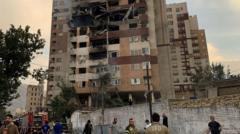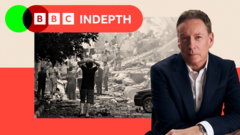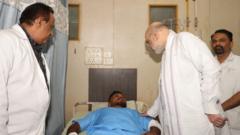Recent Iranian missile attacks on Israel follow retaliatory airstrikes targeting Iran's nuclear facilities, igniting fears of broader military escalation.
**Escalating Conflict: Iran and Israel Exchange Missile Strikes Amid Nuclear Tensions**

**Escalating Conflict: Iran and Israel Exchange Missile Strikes Amid Nuclear Tensions**
As missile strikes intensify between Iran and Israel, the conflict raises global concerns about regional stability and nuclear threats.
June 13, 2025, has witnessed a severe escalation in the ongoing conflict between Iran and Israel, triggered by a series of missile strikes that have heightened tensions across the region. Following Israeli airstrikes on Iranian nuclear facilities, including the critical Natanz site, Iran launched retaliatory missile attacks that struck multiple locations in Israel, particularly around Tel Aviv.
Israeli military officials reported that at least seven sites in Tel Aviv and surrounding areas were hit by Iranian missiles, resulting in injuries to over 22 individuals. Eyewitness reports described a large explosion in the city, with visible fires erupting from damaged buildings. In response, the Israeli defense minister claimed Iran had "crossed a red line" and warned of severe repercussions for its actions.
As the situation escalated, video footage captured the interception of missiles by Israel's Iron Dome defense system, although some missiles managed to evade interception, leading to buildings being hit and damage reported. The extent of injuries among civilians ranges from light to critical, according to local hospitals.
In the backdrop of these exchanges, Rafael Grossi, the head of the U.N.'s nuclear watchdog, confirmed significant damage to Iran's nuclear capabilities, including the destruction of its above-ground enrichment facility at Natanz and potential contamination concerns stemming from the attack. Iranian officials reported substantial casualties from the initial Israeli airstrikes, with figures indicating at least 78 dead and hundreds injured.
The geopolitical landscape has shifted dramatically with the involvement of key global players. Following these developments, U.S. President Trump spoke with Israeli Prime Minister Netanyahu, emphasizing America’s support for Israel while calling for diplomatic solutions. Other world leaders, including figures from Europe, expressed concern over escalating military conflicts and the need for restraint, fearing the potential for regional destabilization and increased oil prices.
Iran's supreme leader, Ayatollah Khamenei, vowed a forceful response to Israeli assaults, stating that Israel would face "harsh punishment." Furthermore, Iranian military leadership claimed precise attacks on Israeli targets, claiming their operations targeted civilian and military infrastructure as a countermeasure.
In light of these developments, academic and military experts warn that unless Iran’s fortified Fordo facility is disabled, the ongoing Israeli operation may remain incomplete. Fordo, a heavily protected site, is crucial to Iran's nuclear ambitions and poses significant challenges for any military interventions aimed at crippling the nation's weapons production capabilities.
This intensifying conflict demonstrates that both nations are prepared for continued confrontation, with implications not only for Israel and Iran but for the entire Middle Eastern geopolitical framework, raising concerns about the potential for wider conflict and instability in an already volatile region.
Israeli military officials reported that at least seven sites in Tel Aviv and surrounding areas were hit by Iranian missiles, resulting in injuries to over 22 individuals. Eyewitness reports described a large explosion in the city, with visible fires erupting from damaged buildings. In response, the Israeli defense minister claimed Iran had "crossed a red line" and warned of severe repercussions for its actions.
As the situation escalated, video footage captured the interception of missiles by Israel's Iron Dome defense system, although some missiles managed to evade interception, leading to buildings being hit and damage reported. The extent of injuries among civilians ranges from light to critical, according to local hospitals.
In the backdrop of these exchanges, Rafael Grossi, the head of the U.N.'s nuclear watchdog, confirmed significant damage to Iran's nuclear capabilities, including the destruction of its above-ground enrichment facility at Natanz and potential contamination concerns stemming from the attack. Iranian officials reported substantial casualties from the initial Israeli airstrikes, with figures indicating at least 78 dead and hundreds injured.
The geopolitical landscape has shifted dramatically with the involvement of key global players. Following these developments, U.S. President Trump spoke with Israeli Prime Minister Netanyahu, emphasizing America’s support for Israel while calling for diplomatic solutions. Other world leaders, including figures from Europe, expressed concern over escalating military conflicts and the need for restraint, fearing the potential for regional destabilization and increased oil prices.
Iran's supreme leader, Ayatollah Khamenei, vowed a forceful response to Israeli assaults, stating that Israel would face "harsh punishment." Furthermore, Iranian military leadership claimed precise attacks on Israeli targets, claiming their operations targeted civilian and military infrastructure as a countermeasure.
In light of these developments, academic and military experts warn that unless Iran’s fortified Fordo facility is disabled, the ongoing Israeli operation may remain incomplete. Fordo, a heavily protected site, is crucial to Iran's nuclear ambitions and poses significant challenges for any military interventions aimed at crippling the nation's weapons production capabilities.
This intensifying conflict demonstrates that both nations are prepared for continued confrontation, with implications not only for Israel and Iran but for the entire Middle Eastern geopolitical framework, raising concerns about the potential for wider conflict and instability in an already volatile region.


















